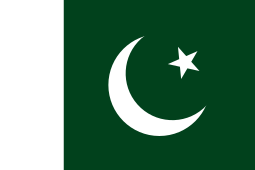 | |
| پرچمِ ستارہ و ہلال ('Flag of the Star and Crescent') | |
| Use | National flag |
|---|---|
| Proportion | 2:3 |
| Adopted | 11 August 1947 |
| Design | A white star and crescent on a dark green field, with a vertical white stripe at the hoist |
| Designed by | Amiruddin Kidwai |
| Part of a series on the |
| Culture of Pakistan |
|---|
 |
| Traditions |
| folklore |
| Sport |
The national flag of Pakistan, also known as the Flag of the Star and Crescent (پرچمِ ستارہ و ہلال), is made up of a green field with a stylized tilted white decending crescent moon and five-pointed star at its centre, and a vertical white stripe at its hoist-end. Though the specific shade of green on the flag is mandated only as 'dark green',[1] its official and most consistent representation is in Pakistan green, which is shaded distinctively darker. It was adopted by the Constituent Assembly of Pakistan on 11 August 1947, and it became the official flag of the Dominion of Pakistan on 14 August 1947, following independence from the British Empire.[2][3][4] The flag was subsequently retained as that of the Islamic Republic of Pakistan in 1956 and remains in use as the national flag to this day.
Most notably, the flag is referred to in the third verse of Pakistan's national anthem, and is widely flown on several important days of the year, including Republic Day, Independence Day and Defence Day. It is also hoisted every morning at schools, offices and government buildings to the playing of the national anthem and lowered again before sunset. A very elaborate flag-raising and lowering ceremony is carried out every evening by the Pakistan Rangers and their Indian Border Security Force counterparts at the Wagah–Attari border crossing between India and Pakistan, which is regularly attended by hundreds of spectators. The Government of Pakistan has formalized rules and regulations related to the flying of the national flag; it is to be displayed all day at full-mast on 23 March annually to commemorate the adoption of the Lahore Resolution in 1940 and the declaration of Pakistan as an independent Islamic republic with a constitution in 1956, both of which occurred on the same day. The same regulations also apply on 14 August annually, in celebration of Pakistan's day of independence; when the country was carved out from erstwhile British India as the homeland and nation-state for the Muslims of the Indian subcontinent.
- ^ "Government of Pakistan: Flag description". Pakistan.gov.pk. Archived from the original on 17 January 2008. Retrieved 11 December 2007.
- ^ "Pakistan Flag specification: Resolution Passed by Constituent Assembly". Pakistan.org. Archived from the original on 12 November 2007. Retrieved 11 December 2007.
- ^ "Parliamentary History". National Assembly of Pakistan. Archived from the original on 24 October 2007. Retrieved 11 December 2007.
- ^ "Parliamentary History of Pakistan" (PDF). Parliamentary Division, Government of Pakistan. Archived from the original (PDF) on 16 February 2008. Retrieved 11 December 2007.